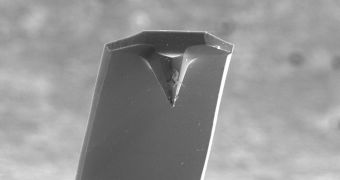Researchers at the Massachusetts Institute of Technology (MIT), in the United States, announce the development of a new, highly-sensitive microscopy technique that is capable of tracking the actions of cellular agents in real-time. The device can watch how special proteins destroy bacterial cells by penetrating their membrane, and this type of studies has never before been conducted live. The team that created this technique was led by professor Angela Belcher.
Many research groups around the world have over the past 20 years recognized the importance of proteins known as antimicrobial peptides (AMP) in fighting off bacterial infections. However, while the positive effects were indeed visible, the specialists had no way of learning precisely how the proteins act. Knowing this could allow investigators to create more advanced versions of these agents, so as to increase their efficiency, and decrease the time they need to act. With the help of the new MIT-developed technology, researchers are now able to do this, and observe how AMP pierce holes in bacterial cell membranes, basically disabling them.
The basis of the technique was an already-sensitive method known as high-speed atomic force microscopy (AFM), which is more commonly known for being able to image a sample down to atomic resolution. With the improvements that Belcher's team brought to this type of microscopy, AFM is now capable of observing living cells using high-resolution images, recorded in rapid succession. The thing about standard microscopes of this type is that they generally take a few minutes to record a single image, and are therefore not suited for live observations. Details of the accomplishment are published in the March 14 online issue of the respected scientific journal Nature Nanotechnology.
During the observations, the team noticed some fairly interesting phenomena. For once, even though the AMP had been injected in all target cells at the same time, they did not kill the microorganisms at the same time. The proteins have a two-strike action, first incubating for a little while, and then instantly delivering a lethal blow to the cells. But the incubation period lasted from 13 to 80 seconds. Researchers are still puzzled as to why that happened, given that all the target cells and all the AMP were perfectly identical. Partial funding for the new work came from the US National Institutes of Health (NIH) and the Army Research Office (ARO).

 14 DAY TRIAL //
14 DAY TRIAL //